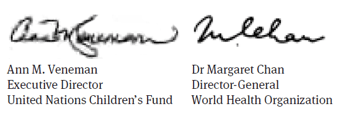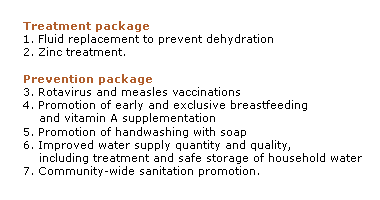7 Point Plan
Foreword

The Millennium Development Goals call for a
reduction of child mortality by two thirds between 1990 and 2015. As the deadline approaches, the
reality is that although progress is being made, much more remains to be done.
Nearly nine million children under five years of age die each year. Diarrhoea is second only to
pneumonia as the cause of these deaths. Why is diarrhoea, an easily preventable and treatable
disease, one that in the developed world is considered little more than an inconvenience, causing an
estimated 1.5 million under-five deaths every year?
Reducing these deaths depends largely on delivering life-saving treatment of low-osmolarity oral
rehydration salts (ORS) and zinc tablets to all children in need. However, progress will also
require focusing on prevention, whether through the new rotavirus vaccine or by addressing the
factors that lead to children developing the disease in the first place.
Diarrhoea is more prevalent in the developing world due, in large part, to the lack of safe drinking water,
sanitation and hygiene, as well as poorer overall health and nutritional status. According to the latest
available figures, an estimated 2.5 billion people lack improved sanitation facilities, and nearly one
billion people do not have access to safe drinking water. These unsanitary environments allow
diarrhoea-causing pathogens to spread more easily.
Improving unsanitary environments alone, however, will not be enough as long as children
continue to remain susceptible to the disease and are not effectively treated once it begins. Evidence
has shown that children with poor health and nutritional status are more vulnerable to serious
infections like acute diarrhoea and suffer multiple episodes every year. At the same time, acute and prolonged diarrhoea seriously exacerbates poor
health and malnutrition in children, creating a deadly cycle.
In the 1970s and 1980s, the international community committed itself to reducing child mortality from
diarrhoea largely by scaling up the use of oral rehydration therapy – a low-cost and highly effective
solution – coupled with programmes to educate caregivers on its appropriate use. The effort met
with great success. Yet today only about 39 per cent of children with diarrhoea in the developing world
receive oral rehydration therapy and continued feeding, a figure that has changed little since 2000.
This report sets out a 7-point strategy for comprehensive diarrhoea control that includes a treatment
package to reduce child deaths, and a prevention package to reduce the number of diarrhoea cases
for years to come. The report looks at treatment options such as low-osmolarity ORS and zinc
tablets, as well as prevention measures such as the promotion of breastfeeding, vitamin A supplementation,
immunization against rotavirus – a leading cause of diarrhoea – and proven methods of
improving water, sanitation and hygiene practices.
Diarrhoea’s status as the second leading killer of children under five is an alarming reminder of the
exceptional vulnerability of children in developing countries. Saving the lives of millions of children at
risk of death from diarrhoea is possible with a comprehensive strategy that ensures all children in need
receive critical prevention and treatment measures.






 The Millennium Development Goals call for a
reduction of child mortality by two thirds between 1990 and 2015. As the deadline approaches, the
reality is that although progress is being made, much more remains to be done.
The Millennium Development Goals call for a
reduction of child mortality by two thirds between 1990 and 2015. As the deadline approaches, the
reality is that although progress is being made, much more remains to be done.